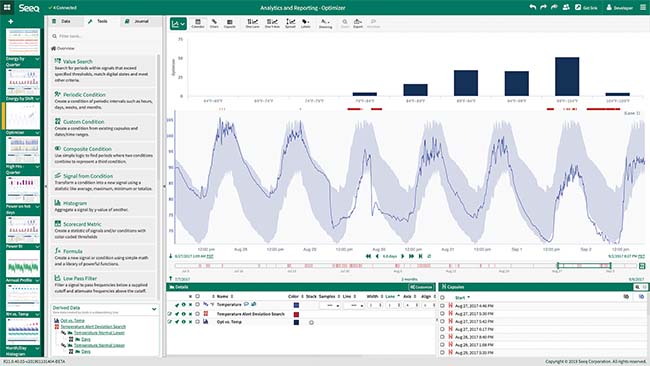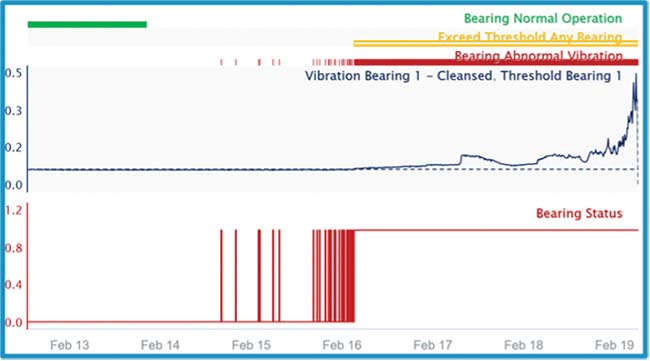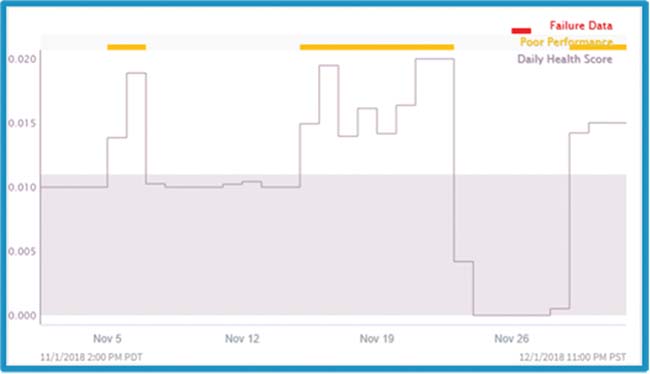Moving from reactive to predictive maintenance requires the right tools for use by subject matter experts.
As the power industry continues to advance from preventative to predictive maintenance, one thing is clear. Access to robust data and the ability to use it intelligently are the foundational elements of effective predictive maintenance. However, this is not easy to achieve, and the process must start at the most basic levels with the ability to cleanse and contextualize data.
Establishing an asset health model using a predictive method must focus on as many variables as possible and include data from the manufacturer’s asset specification, nameplate, past services performed, and repairs. This and other data are needed to meet an asset’s failure and performance objectives. Predictive maintenance also helps pinpoint corrective actions, and it can extend asset life.
Implementing this type of predictive maintenance strategy requires an understanding of how and why asset failure occurs, along with early identification of potential problems or failure. Many of these conditions are hidden in the data that is already sitting in an organization’s process historian.
Looking back and understanding the correlation between data and its variations can help identify many failure trends. These maintenance techniques are an iterative process and may require additional inputs to refine the models. They should continue to evolve and are designed to predict the useful life of an asset, as well as to determine maintenance schedules.
Predictive maintenance, in conjunction with past preventive and reactive maintenance strategies, provides plant personnel with the information needed to cut costs and maximize uptime. A properly implemented strategy will eliminate costly downtime and provide optimal preventive maintenance schedules, but this is more easily said than done, with some strategies more effective than others.
Advancing from Reactive to Proactive Maintenance
Maintenance without adequate planning negatively affects reliability and operations, causes equipment to degrade, and increases operating costs. While organizations understand this challenge, they must next determine just when maintenance should be performed, and to what extent.
Limiting maintenance saves money initially but will lead to higher costs in the long term. On the other hand, while excessive maintenance will reduce outages and failures, its higher cost may appear extreme because it is difficult to measure the cost savings from avoided incidents. The key to improved reliability is directly related to an optimized approach for operations and maintenance.
Preventive maintenance has become the industry standard, and it provides schedules for inspections, testing, repairs, and replacement of critical assets and components. It is typically done on a calendar or time interval and will extend the asset’s life, reduce premature failures, and increase availability.
This type of time-based maintenance has also helped establish standards and techniques that improve the estimated lifespan of an asset, while providing a baseline for understanding time-driven conditions leading to failure. This has been a vast improvement from purely reactive maintenance.
Predictive maintenance programs are the next step and are becoming easier to implement as utilities take advantage of increased available data. Analysis of this data provides valuable insights to determine equipment condition, and cuts cost by optimizing when maintenance is performed, and to what extent. These types of programs can also be used to predict asset failures before they occur, avoiding unscheduled downtime.
Utilizing predictive analytics increases awareness for improvements, provides accurate forecasting, and helps advance data-driven decisions for optimization. However, the data and context must be handled properly because with the wrong tools, subject matter experts (SMEs) can spend days or weeks conditioning, verifying, and contextualizing data. These issues become more serious as the amount of data grows, along with its granularity and complexity. Spreadsheets can no longer handle these data volumes, requiring a transition to more robust solutions.
Sophisticated Solutions Empower Experts
Advanced analytics applications are purpose-built for analyzing the type of time-series data generated by the types of assets found in power generation facilities. These applications provide a comprehensive solution for managing predictive models, along with the vast amounts of data from multiple disparate systems (Figure 1).
 |
|
1. Advanced analytics applications provide the tools required for cleansing, contextualizing, and analyzing large and complex data sets to create insights. Courtesy: Seeq |
Advanced analytics applications connect to existing data silos and other sources, without copying or duplicating the data from source systems. Once these data sources are connected, the application can be used by SMEs for diagnostic, predictive, and descriptive analytics. These applications also provide improved real-time collaboration, enabling greater vision and insights across teams, and ultimately accelerating the communication of insights across the broader organization.
With advanced analytics applications, ensuring data integrity, and cleansing and contextualizing time-series data, is much quicker and easier. This type of data is often noisy, including small spikes and erroneous values, which can complicate the analysis. Cleansing data with smoothing filters to eliminate or reduce the noise is a necessary first step to contextualization. In addition to signal smoothing, SMEs can leverage advanced analytics applications to remove outliers, time shift data to adjust for different intervals, and eliminate data that is not relevant, such as when an asset is not operating or is in startup mode.
As the power industry continues to look for solutions around predictive analytics, machine learning, and data science, it must efficiently utilize the expertise of its existing workforce. The collaboration and knowledge of process engineers and experts will be required to assemble a data-driven analytics effort to rapidly distribute insights and improve outcomes. With advanced analytics applications, these and other issues can be addressed by connecting to data and landing insights, eventually leading to improved business and production results, as shown in the following examples.
Bearing Failure Prediction
Rotating machinery presents challenges when establishing proper maintenance and servicing schedules. Specifically, bearings can fail with little notice, making scheduled maintenance very difficult. System interdependence often means that a failure of one bearing results in subsequent failure of others. SMEs can use an advanced analytics application to cleanse equipment data, identify normal operating conditions, calculate statistical thresholds, and identify any deviations or abnormalities.
In one scenario, data scientists used data cleansed and contextualized by their SMEs to build a bearing health status signal. This was done by running an anomaly detection algorithm, with results shared across the company.
Maintenance is now notified of abnormal operation days before a catastrophic failure. This early warning time enables proactive greasing of bearings to extend run life, and to provide time for advanced parts ordering and resource allocation.
The data that was used to configure the bearing prediction model was already residing within the process data historian, and it was correlated with the data from periodic vendor testing that was stored as CSV files and uploaded to the advanced analytics application. The data was then structured into an asset hierarchy, enabling calculations to be quickly propagated from one bearing to many others.
 |
|
2. View of the anomaly detection algorithm overlaid with the original failure detection calculations. The red condition begins to show signs of failure days before the yellow condition occurs. Courtesy: Seeq |
The anomaly detection signals were pushed back to the advanced analytics application, and SMEs used this information for daily monitoring to identify potential bearing failures earlier. The results were added into a dashboard. A graph was also created to provide more detailed information related to the predicted time of bearing failure (Figure 2). This information was used to schedule proactive maintenance in advance of bearing failure.
Pump Health Monitoring
Pump health monitoring has become increasingly important and has led to better methods for measuring performance, along with the ability to gauge pump health in near real time. Implementing a condition-based monitoring analysis to monitor pump health across hundreds of assets requires access to historical data for creating a predictive maintenance forecast to detect failures before they occur. The state of overall pump health is informed by monitoring performance and identifying any degrading conditions or risks, allowing for prioritization of maintenance activities.
 |
|
3. The daily health score for this pump provides a detailed view showing leading indicators that could contribute to poor performance, and eventually failure. Courtesy: Seeq |
Using Seeq, required data is accessed from asset management systems to define models for normal operating conditions. SMEs then cleanse the data to remove outliers, noise, and dropouts. Calculations and conditions are then applied to create a histogram (Figure 3) displaying the time each pump is in a certain mode of operation, such as:
- ■ Good or Poor.
- ■ Percent time calculation in different poor modes of operation.
- ■ Percent magnitude of violation during the poor modes of operation.
These results are displayed for reporting and collaboration. Using Seeq, dashboards with automatic updates to show pump health across all assets were created to aid troubleshooting efforts. Cleansed data was also provided to reliability engineers for performing root cause analysis.
Advanced Tools Are Available Today
Predictive analytics adds insight and clarity, and it is quickly becoming more attainable due to the confluence of big data and advanced analytics applications. These applications are revolutionizing the way data is analyzed, making it possible for SMEs, engineers, and data scientists to make strategic decisions.
Advanced analytic applications have made it simpler for a wider range of personas to leverage predictive analytics and perform faster analyses. These applications also enable organizations to expand predictive analytics to identify patterns using machine learning, requiring less operator intervention for recognition between cause and result, while automatically adjusting models to deal with new data. With advanced analytics applications, these and other benefits are realized through the rapid iteration and refinement of analyses, providing more accurate and timely insights.
—Giro Iuliano is an industry principal at Seeq Corp. He has nearly 20 years of sales and business development experience, having worked for a decade with power and utilities customers at OSIsoft, and five plus years at Oracle and Itron.











